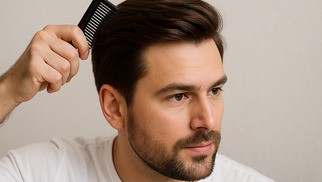Thinning Hair: Causes, Treatments, and How to Regrow It


Hair thinning is a common concern that affects millions of individuals across the globe, irrespective of gender, age, or ethnicity. Unlike complete hair loss or baldness, thinning hair refers to a reduction in the density or volume of hair on the scalp. This gradual process can lead to a noticeable reduction in hair coverage and often results in emotional distress, lowered self-confidence, and concerns about aging or health.
Understanding the nature of hair thinning, its underlying causes, available treatments, and preventive strategies is essential for managing the condition effectively. Advances in dermatology and pharmacology, including the use of medications such as Morr (a topical minoxidil formulation), have created new opportunities for individuals to combat thinning and restore fuller hair over time.
Can Thinning Hair Grow Back?
One of the most common questions patients ask is whether thinning hair can grow back. The answer depends largely on the underlying cause of the thinning, the degree of hair follicle damage, and how early intervention begins.
In many cases, thinning hair can grow back, especially when the follicles are still active but dormant or miniaturized. Early-stage hair thinning, particularly when associated with stress, nutritional deficiencies, hormonal fluctuations, or temporary shedding conditions like telogen effluvium, is often reversible. Once the triggering factor is removed or corrected, hair regrowth may occur naturally or with the help of treatment.
However, if thinning progresses to the point where follicles have become fibrotic or scarred (as seen in scarring alopecias), hair regrowth becomes unlikely. Similarly, advanced androgenetic alopecia — where hair follicles progressively shrink and eventually die — can be more difficult to reverse, although medications can slow progression and sometimes partially restore growth.
Effective management therefore depends not only on treating symptoms but also on early diagnosis and targeted intervention. A comprehensive hair assessment by a dermatologist or trichologist can help determine the viability of regrowth.
What Is the Main Cause of Hair Thinning?
Hair thinning can result from a multitude of biological, environmental, and lifestyle-related factors. One of the most prevalent causes is androgenetic alopecia, also known as male-pattern or female-pattern hair loss. This hereditary condition is influenced by androgens, particularly dihydrotestosterone (DHT), which bind to hair follicles and gradually shrink them over time. This miniaturization reduces hair shaft thickness and ultimately limits hair production.
Another common cause is telogen effluvium, a condition in which a large number of hairs enter the resting (telogen) phase prematurely, resulting in increased shedding. Telogen effluvium is typically triggered by physical or emotional stress, illness, surgery, childbirth, or significant weight loss. While it is often reversible, it can persist for months if the trigger remains unaddressed.
Nutritional deficiencies — especially of iron, zinc, vitamin D, and biotin — can lead to weakened hair structure and slow growth. Thyroid dysfunction, particularly hypothyroidism, is another important endocrine-related cause of thinning hair. Similarly, autoimmune diseases such as alopecia areata, lupus, or lichen planopilaris can lead to patchy or diffuse hair thinning depending on the severity and location of immune activity.
Certain hairstyling practices, including excessive heat, chemical treatments, and tight hairstyles, can damage hair shafts and follicles over time. This can lead to traction alopecia and eventually hair loss if the practices are not modified.
Finally, aging itself leads to a natural slowing of hair growth and a reduction in follicle density. While this process is gradual, it contributes significantly to overall thinning in both men and women as they age.
How Do I Stop My Hair from Thinning?
Preventing or slowing hair thinning requires identifying and addressing the specific cause, as well as adopting a proactive approach to scalp and follicular health. In many cases, changes in lifestyle and routine can produce measurable improvements in hair quality and volume.
Nutritional balance plays a foundational role in maintaining healthy hair. A diet rich in proteins, vitamins, and trace minerals supports hair growth cycles and reduces shedding. For individuals with confirmed deficiencies, supplementation may be necessary under the supervision of a healthcare provider.
Managing stress is crucial for individuals experiencing stress-related telogen effluvium. Practices such as mindfulness, meditation, and physical activity may help modulate hormonal changes that negatively affect hair cycles.
Gentle hair care is essential. Avoiding overuse of heat tools, limiting chemical processing, using sulfate-free shampoos, and minimizing physical tension on hair shafts can protect the follicles from chronic damage.
When underlying medical conditions such as thyroid disease, polycystic ovary syndrome (PCOS), or autoimmune disorders are involved, proper medical management can prevent ongoing follicular impairment.
In cases where hormonal imbalance or androgen sensitivity is the driving factor, medical treatments such as finasteride (for men) or spironolactone (for women) may be prescribed. These drugs work by reducing androgen activity at the follicle level, thus slowing or halting miniaturization.
Topical treatments like minoxidil have also proven effective in many cases of hair thinning. Their mode of action includes prolonging the anagen (growth) phase of the hair cycle and enlarging shrunken follicles, resulting in thicker strands and improved hair density.
What Are the Big 3 for Thinning Hair?
In the context of hair loss treatment, the term “Big 3” refers to three widely regarded interventions that address different mechanisms of thinning and have shown measurable efficacy in clinical and anecdotal reports. These three are minoxidil, finasteride, and ketoconazole.
Minoxidil, originally developed as a blood pressure medication, is now a standard over-the-counter topical treatment for hair loss. It acts as a vasodilator and may stimulate follicular activity by improving scalp blood flow, extending the hair growth phase, and reversing follicular miniaturization.
Finasteride is a prescription medication that inhibits the enzyme 5-alpha-reductase, which converts testosterone to DHT. By lowering DHT levels, finasteride helps prevent the hormonal assault on hair follicles seen in androgenetic alopecia. It is primarily used in men and has been associated with both regrowth and reduction in further loss.
Ketoconazole, an antifungal agent found in some medicated shampoos, has been shown to have anti-inflammatory and anti-androgenic effects on the scalp. Its use can reduce scalp inflammation, seborrheic dermatitis, and possibly DHT activity, creating a more favorable environment for hair retention and regrowth.
These three therapies are often combined in personalized regimens, particularly for those with early-to-moderate male pattern hair loss. Although not suitable for everyone—particularly women or individuals with specific contraindications—they represent the foundation of modern pharmacological management for thinning hair.
The Role of Morr in the Treatment of Thinning Hair
Morr is a commercially available brand of topical minoxidil, used widely in the treatment of androgenetic alopecia and other forms of hair thinning. It is available in various concentrations, commonly 2% and 5%, and is applied directly to the scalp once or twice daily.
Minoxidil, the active ingredient in Morr, works through several mechanisms. It prolongs the anagen phase, increases follicle size, and improves blood flow to the scalp. These combined actions help revive dormant follicles and increase the production of thicker, stronger hair shafts.
Morr is particularly effective when used consistently over a period of several months. It is not a cure but rather a management tool that must be maintained for continued benefits.Discontinuation often leads to the return of hair loss within a few months.
The product is generally well-tolerated, though some users may experience local irritation, dryness, or flaking of the scalp. Rare systemic side effects may occur if the product is overused or applied incorrectly. It is important to follow instructions closely and consult a healthcare professional before beginning treatment, especially for those with sensitive skin or underlying medical conditions.
Morr can be used as monotherapy or in combination with oral medications like finasteride in men, or spironolactone and oral contraceptives in women with hormonal hair loss. For women, the 2% concentration is usually recommended, though some may tolerate and benefit from the 5% version under medical guidance.
The success of Morr largely depends on the user’s consistency, scalp condition, and stage of hair loss. It is most effective in individuals with recent or moderate thinning and less likely to yield visible results in cases where the scalp has become extensively bald or the follicles are permanently inactive.
Conclusion
Hair thinning is a multifactorial condition with emotional, cosmetic, and medical implications. While it may be triggered by genetic, hormonal, nutritional, or environmental factors, it is often manageable — especially when identified early and approached systematically.
Recovery from thinning hair is possible for many individuals, particularly when follicles are still viable. A combination of nutritional support, lifestyle adjustments, medical evaluation, and pharmacological treatments like Morr can create an environment conducive to hair stabilization and regrowth.
For best outcomes, individualized treatment plans based on a proper diagnosis and regular monitoring should be developed. By understanding the nature of hair thinning and using evidence-based solutions, individuals can regain not just their hair, but also their confidence and peace of mind.
Article Post:Editorial Team of RXShop.md
(Updated at May 23 / 2025)

